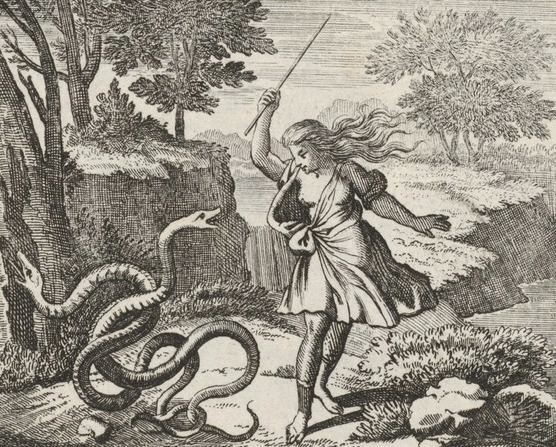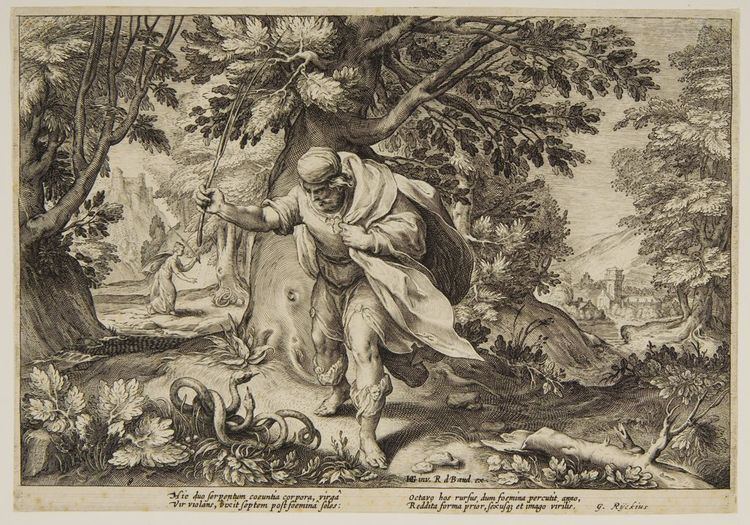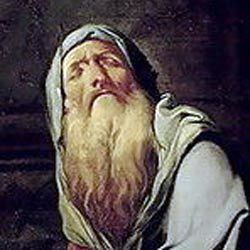 | ||
Played by Christopher Lee, Julian Beck, Kim Coates, Alfredo Varelli, William Dennis Hunt Similar Creonte, Oedipus, Jocasta, Haemon, Ismene | ||
In Greek mythology, Tiresias (/taɪˈriːsiəs/; Greek: Τειρεσίας, Teiresias) was a blind prophet of Apollo in Thebes, famous for clairvoyance and for being transformed into a woman for seven years. He was the son of the shepherd Everes and the nymph Chariclo. Tiresias participated fully in seven generations in Thebes, beginning as advisor to Cadmus himself.
Contents

Tiresias
Overview

Eighteen allusions to mythic Tiresias, noted by Luc Brisson, fall into three groups: one, in two episodes, recounts Tiresias' sex-change and his encounter with Zeus and Hera; a second group recounts his blinding by Athena; a third, all but lost, seems to have recounted the misadventures of Tiresias.

How Tiresias obtained his information varied: sometimes, like the oracles, he would receive visions; other times he would listen for the songs of birds, or ask for a description of visions and pictures appearing within the smoke of burnt offerings, and so interpret them.

On Mount Cyllene in the Peloponnese, as Tiresias came upon a pair of copulating snakes, he hit the pair with his stick. Hera was displeased, and she punished Tiresias by transforming him into a woman. As a woman, Tiresias became a priestess of Hera, married and had children, including Manto, who also possessed the gift of prophecy. According to some versions of the tale, Lady Tiresias was a prostitute of great renown. After seven years as a woman, Tiresias again found mating snakes; depending on the myth, either she made sure to leave the snakes alone this time, or, according to Hyginus, trampled on them. As a result, Tiresias was released from his sentence and permitted to regain his masculinity. This ancient story is recorded in lost lines of Hesiod.
In Hellenistic and Roman times Tiresias' sex-change was embroidered upon and expanded into seven episodes, with appropriate amours in each, probably written by the Alexandrian Ptolemaeus Chennus, but attributed by Eustathius to Sostratus of Phanagoria's lost elegiac Tiresias. Tiresias is presented as a complexly liminal figure, mediating between humankind and the gods, male and female, blind and seeing, present and future, this world and the Underworld.
According to the mythographic compendium Bibliotheke, different stories were told of the cause of his blindness, the most direct being that he was simply blinded by the gods for revealing their secrets. An alternative story told by the poet Pherecydes was followed in Callimachus' poem "The Bathing of Pallas"; in it, Tiresias was blinded by Athena after he stumbled onto her bathing naked. His mother, Chariclo, a nymph of Athena, begged Athena to undo her curse, but the goddess could not; instead, she cleaned his ears, giving him the ability to understand birdsong, thus the gift of augury. In a separate episode, Tiresias was drawn into an argument between Hera and her husband Zeus, on the theme of who has more pleasure in sex: the man, as Hera claimed; or, as Zeus claimed, the woman, as Tiresias had experienced both. Tiresias replied, "Of ten parts a man enjoys one only." Hera instantly struck him blind for his impiety. Zeus could do nothing to stop her or reverse her curse, but in recompense he did give Tiresias the gift of foresight and a lifespan of seven lives.
He is said to have understood the language of birds and could divine the future from indications in fire, or smoke. However it was the communications of the dead he relied the most on, menacing them when they were late to attend him.
Tiresias makes a dramatic appearance in the Odyssey, book XI, in which Odysseus calls up the spirits of the dead (the nekyia). "So sentient is Tiresias, even in death," observes Marina Warner "that he comes up to Odysseus and recognizes him and calls him by name before he has drunk the black blood of the sacrifice; even Odysseus' own mother cannot accomplish this, but must drink deep before her ghost can see her son for himself."
As a seer, "Tiresias" was "a common title for soothsayers throughout Greek legendary history" (Graves 1960, 105.5). In Greek literature, Tiresias' pronouncements are always given in short maxims which are often cryptic (gnomic), but never wrong. Often when his name is attached to a mythic prophecy, it is introduced simply to supply a personality to the generic example of a seer, not by any inherent connection of Tiresias with the myth: thus it is Tiresias who tells Amphytrion of Zeus and Alcmena and warns the mother of Narcissus that the boy will thrive as long as he never knows himself. This is his emblematic role in tragedy (see below). Like most oracles, he is generally extremely reluctant to offer the whole of what he sees in his visions.
Tiresias and Thebes
Tiresias appears as the name of a recurring character in several stories and Greek tragedies concerning the legendary history of Thebes. In The Bacchae, by Euripides, Tiresias appears with Cadmus, the founder and first king of Thebes, to warn the current king Pentheus against denouncing Dionysus as a god. Along with Cadmus, he dresses as a worshiper of Dionysus to go up the mountain to honor the new god with the Theban women in their Bacchic revels.
In Sophocles' Oedipus Rex, Oedipus, the king of Thebes, calls upon Tiresias to aid in the investigation of the killing of the previous king Laius. At first, Tiresias refuses to give a direct answer and instead hints that the killer is someone Oedipus really does not wish to find. However, after being provoked to anger by Oedipus' accusation first that he has no foresight and then that Tiresias had a hand in the murder, he reveals that in fact it was Oedipus himself who had (unwittingly) committed the crime. Outraged, Oedipus throws him out of the palace, but then afterwards realizes the truth.
Oedipus has handed over the rule of Thebes to his sons Eteocles and Polynices but Eteocles refused to share the throne with his brother. Aeschylus' Seven Against Thebes recounts the story of the war which followed. In it, Eteocles and Polynices kill each other.
Tiresias also appears in Sophocles' Antigone. Creon, now king of Thebes, refuses to allow Polynices to be buried. His niece, Antigone, defies the order and is caught; Creon decrees that she is to be buried alive. The gods express their disapproval of Creon's decision through Tiresias, who tells Creon 'the city is sick through your fault.' However, Antigone has already hanged herself rather than be buried alive. When Creon arrives at the tomb where she is to be interred, his son, Haemon who was betrothed to Antigone, attacks Creon and then kills himself. When Creon's wife, Eurydice, is informed of her son and Antigone's deaths, she too takes her own life.
Tiresias and his prophecy are also involved in the story of the Epigoni.
Death
Tiresias died after drinking water from the tainted spring Tilphussa, where he was struck by an arrow of Apollo.
His shade descended to the Asphodel Meadows, the first level of Hades. After his death, he was visited in the underworld by Odysseus to whom he gave valuable advice concerning the rest of his odyssey, such as how to get past Scylla and Charybdis. He even gave him advice where he should not eat the cattle of Helios on Thrinacia (advice which Odysseus' men did not follow which led to Odysseus' men getting killed by Zeus' thunderbolts during a storm).
The caduceus
Connections with the paired serpents on the caduceus are often made (Brisson 1976:55–57).
